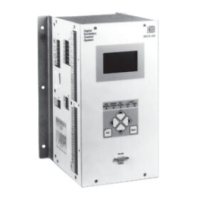3-2 Functional Description DECS-200
Contact Input Circuits
Eleven contact input circuits, powered by isolated 12 Vdc, provide operational input control for the DECS-
200. If the start and stop inputs should become active at the same time, the stop input has priority. If the
AVR and FCR inputs should become active at the same time, the FCR input has priority. Each of the
eleven inputs, their functions, and types of input required are defined in the following paragraphs.
Start
This input accepts a momentary contact closure and enables the DECS-200. Once the DECS-200 is
enabled, this input has no effect.
Stop
This input accepts a momentary contact closure and disables the DECS-200. Once the DECS-200 is
disabled, this input has no effect. The Stop input also take precedence over the Start input.
AVR (Automatic Voltage Regulation)
This input accepts a momentary contact closure that places the DECS-200 in AVR mode. Once the
DECS-200 is in AVR mode, this input has no effect.
FCR (Field Current Regulation)
This input accepts a momentary contact closure that places the DECS-200 in FCR mode. Once the unit is
in FCR mode, this input has no effect. The FCR input takes precedence over the AVR input.
Raise
This input increases the active operating setpoint. This function is active as long as the contact is closed.
The raise increment is a function of the setpoint range of adjustment and the active mode traverse rate.
The increments are directly proportional to the adjustment range and inversely proportional to the traverse
rate. This input has no effect when the active pre-position mode is Maintain.
Lower
This input decreases the active operating setpoint. This function is active as long as the contact is closed.
The lower increment is a function of the setpoint range of adjustment and the active mode traverse rate.
The increments are directly proportional to the adjustment range and inversely proportional to the traverse
rate. This input has no effect when the active pre-position mode is Maintain.
PRE-P (Pre-Position)
This input accepts a continuous contact closure that causes all setpoints to be changed to the pre-
position (predefined) value. If the active pre-position mode is Maintain, then the pre-position input will
override the raise and lower inputs to maintain the setpoint at the pre-position value while the contact is
closed. If the active pre-position mode is Release, then the pre-position input will change the setpoint to
the pre-position value and respond to raise and lower inputs.
If the non-active pre-position mode is Maintain and internal tracking is enabled, the non-active mode will
maintain the non-active setpoint at the pre-position value and override the tracking function. If the non-
active pre-position is Release and internal tracking is enabled, then the pre-position input will change the
setpoint to the pre-position value and respond to the tracking function.
Typically, this input is connected to a 52b auxiliary contact on the generator breaker. When the generator
breaker opens, all setpoints are forced to the pre-position settings. This is especially helpful if FCR mode
is active and the generator is under a load. Utilizing a 52b contact will force the FCR setpoint to its pre-
position setting which could be preset to the generator’s no-load, nominal voltage.
52L/M (Unit/Parallel)
This input informs the DECS-200 that the system is operating in single-unit operation or paralleled to
another generator or power grid in droop mode. It also switches between which overexcitation limiter (off-
line limiter or on-line limiter) is activated when excitation levels exceed the OEL settings. This input is
typically connected to a 52b auxiliary contact of the generator breaker and requires a continuous contact
closure to switch modes. Refer to the
52J/K (Var/PF Enable)
paragraph for more information.
If both the 52L/M and 52J/K contact inputs are closed, AVR mode is active while the off-line
overexcitation limiter is enabled and will limit if the settings are exceeded. This mode is intended for
stand-alone (single unit) generator operation.
If the 52L/M contact input is open and 52J/K contact input is closed, droop mode is active while the on-
line overexcitation limiter is enabled and will limit if the settings are exceeded. This mode is intended for

